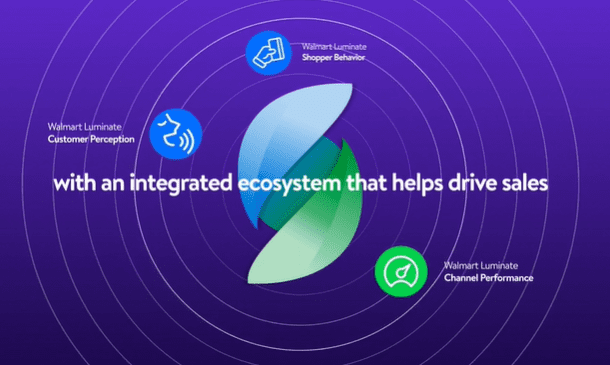Editor’s Note: As 2024 comes to an end, we’re highlighting some of our most-read content of the year. We look forward to continuing to deliver original, thought-provoking stories like this one to our readers in 2025.
If data is the new oil, then Walmart is sitting on a gusher. Three years ago, the company launched a concerted effort to refine and distribute that rich resource, not just for itself but also for its suppliers. The result — a suite of data insights tools called Walmart Luminate — is now being used regularly by Walmart merchants and suppliers under the banner of the company’s Data Ventures division.

Self-professed data and analytics nerd Mark Hardy helped build, and now heads, Walmart’s Data Ventures group, despite swearing that he would “never work for a Fortune 500 company again” after he developed a taste for startup culture later in his career. Walmart hooked him, though, with a job in its (reportedly now defunct) Store No. 8 incubator division, and then drafted him a year later to build Walmart Data Ventures (WDV), calling on his nearly three decades of experience in the space.
Until now, Data Ventures has operated a bit more under the radar than other new Walmart services, like its Connect retail media business or the GoLocal shipping solution. But that’s changing, as evidenced by the appearance of Hardy’s colleague Linda Lomelino, Senior Director of Product Management for WDV, on stage at the NRF Big Show earlier this month.
Hardy sat down with Retail TouchPoints and gave us a deep dive into the development of the Data Ventures unit, what the division aims to do both for Walmart and its suppliers, and some examples of how brands such as Red Bull and Procter & Gamble are already putting all that gorgeous, rich Luminate data to work.
Inside Walmart’s New Data Ventures Division
Retail TouchPoints (RTP): When you started WDV three years ago, what kind of internal data organization had been in place at Walmart?
Mark Hardy: There was a prior team, still called Data Ventures, that existed within Walmart for a couple of years, and they were focused initially on the monetization of data, but unfortunately nothing really came of it. When I got brought in, we really thought through the remit of what we wanted to do. As with most retailers, everybody’s looking for alternative revenue streams, whether it’s advertising, data or other streams. However, what we wanted to do was change the remit around, and that’s why [we now talk about] creating value out of Walmart’s data — and monetization is only one form of creating value.
When we talk about creating value, it’s how do we create visibility on the journey of a product from source to shelf, and the journey of a customer from home to store. Ultimately, the two come together at the shelf, which is the point of conversion. To really maximize that point of conversion, we need to understand the behaviors and attitudes that drive a consumer to decide where they’re going to shop and what they’re going to buy.
That’s where the initial idea of the Walmart Luminate [product suite] came to bear. What Walmart Luminate does is it allows [Walmart] merchants and suppliers, and our partners throughout the entire value chain, to have a single version of truth. We look at how to create visibility into the journey of a product and the journey of a customer so that we understand better the point of conversion.

Within Walmart Luminate, there’s three modules: Shopper Behavior, Channel Performance and Customer Perception. Under Shopper Behavior, we take our tender-traceable data — that’s all the purchases that happen, and we have about 150 million transactions a week — and in an anonymized, aggregated manner, we look at purchase trends. What are people buying? What are the switching patterns or try-and-repeat on new products? And we can look at that on a longitudinal basis, so how are consumer patterns changing? That tells us the “what.”
Then we look at our supply chain data, and we start really understanding where we are in our journey of products from source to shelf. And that allows us to understand what’s being bought, what are the conditions of the store, what’s the assortment, what’s out of stock, what are the “no-picks” for online orders coming from our stores. That gives us the “where.”
The last thing is that we’ve built out a community of Walmart shoppers that have double opted-in, which allows us to actually look at their behaviors and engage them in some surveys, whether it’s just an online survey or a qualitative approach where they use their mobile phones and videos to talk to us and provide us information. We’ve opened this up not only to our merchants and Walmart associates but also to our suppliers, so that we can ultimately understand the “why behind the buy.” By being able to bring the “what,” the “where” and the “why” together, it gives us a visibility and understanding of consumers that allows us to better serve them and make a better experience.
RTP: Do your suppliers pay for this service, or is this just part of having a relationship with Walmart?
Hardy: There are two versions of Walmart Luminate. The Charter version has all three of those modules that I mentioned, and we’ll have other modules coming out. That requires a paid subscription, [through which] you get tremendous visibility and access to data at a really granular level, in real time. There is a second option within Walmart Luminate that only has Channel Performance, which is the module that has our sales and inventory data, that is, our store supply chain data, which we provide to our suppliers who are not interested in being a part of the Charter program. That allows them to actually understand their inventory and sales, and we provide that for free, but that doesn’t give them visibility into the customer behaviors or the community to be able to understand the why behind the buy.
RTP: You mentioned monetization as one of the “whys” behind doing this, but are there other reasons why Walmart has decided to share data with your suppliers in this way?
Hardy: Historically, suppliers would come in with a set of data from disparate sources, using different tools with different methodologies. Then Walmart, our associates and merchants, would also be using different sources of data. So when the two came together, they would spend more time trying to figure out whose data was right than trying to figure out how to use that data to drive the business and a better experience for our customers. Having a single source of truth allows us all to read the same data. We’re working off the same hymnal and the same song. Now we’re spending time actually fixing problems, developing new strategies and improving the customer experience at our stores and online.
Another reason goes back to a shift that we’re seeing in the data industry. Historically, we’ve all used third-party data; we would take that data, which would be a sample that would then be projected to the full world. But that data is no longer as usable as it needs to be because it’s projected data. In today’s world, what we are seeing, especially with the deprecation of cookies, is that consumers want personalization at the same time that they want privacy, and the only solution to that is first-party data. Because that consumer has a relationship with us and we can look at the total environment, not a projected sample of stores, we can look at what actually happens in every single store in real time. Those 150 million transactions a week allow us to be more granular and more accurate, especially when we start thinking about becoming more predictive [in our strategies].
So this entire shift in the data industry that we are seeing, going from third-party to first-party, that’s where the value becomes increasingly important to both Walmart and to its suppliers. We can make better decisions on how to get products to the right place, at the right time, based on what customers are going to do around that store or in that area.
RTP: Another major shift that’s happening is the rise of retail media. How much of what you are doing is connected to the Walmart Connect business?
Hardy: We are increasingly connecting our data to Walmart Connect. Already today, our suppliers and our merchants are gaining insights about what customer behaviors and preferences are. We are then able to use that data to drive more personalized, targeted messages to the customers themselves so that we are relevant to them, rather than just being spam. So we are seeing our data within Walmart Luminate flowing into advertising, into Connect, to help make better decisions, to be more relevant and actually drive ROAS and ROI for all those dollars spent around advertising.
That is one area where the data makes an impact. That same data is also making an impact on the supply side: being able to understand where products are selling and make sure that we get inventory to [the right places] so that we can fulfill the experience that our customers want, whether it’s online or in physical stores.
How Brands like Red Bull and P&G are Putting Luminate to Work
RTP: Do you have any examples of how a Walmart supplier has used Luminate data to tackle a problem, and what the results were?
Hardy: I actually have a couple of different examples based on very different problems. The first one is Red Bull, the energy drink. A lot of their purchases are impulse purchases when someone’s walking out of the store. But as we went through the pandemic, Red Bull found that [with the growth of] online pickup and delivery (OPD), they no longer held the number-one share in energy drinks in OPD. As we dug into the data, what became very apparent was, first, that we had the wrong assortment online, and second, we were not building awareness to [digital] consumers that Red Bull was there. So Red Bull enacted a program with Walmart Connect, along with working with the Walmart merchants to change the assortment of what was available online. Within one quarter they went from being the number two or three player in OPD to being the number one player in OPD for Walmart.
Another example is Bimbo Bakeries, they own Entenmann’s, Arnold bread, Thomas’ English Muffins, Sara Lee, a bunch of brands. That entire category is what’s called “pay from scan,” meaning Walmart says, “Here’s your shelf space,” and the vendor then comes in with their personnel and they put their products on the shelf. Walmart doesn’t pay them until that product is scanned at the register, which is different than most of the products in the store where we actually acquire the inventory.
There are a lot of categories within the store that act that way, like jewelry and greeting cards, but bread is very substitutable. If I order Sara Lee bread but it’s out of stock and it’s an OPD order, the picker will then go and just pick the next bread, like Wonder, and replace it. And usually customers will just say, “Yeah, that’s fine. I wanted Sara Lee, but really what I need is bread.” Walmart still wins because we sold bread, but Bimbo Bakeries loses because their customer, who wanted their product, got a competing product because they were out of stock.
So one of the things we have done with them is they now actually give us their data as they drop off their products in our stores. Previously, we didn’t know what they dropped off, we didn’t know what was there until it sold. Now they’re sending us their data in real time, and we are taking that data and connecting it back to the POS data and delivering it back to Bimbo. So now when their associate walks into our store they actually know what products they have to take in, [they know] what’s missing. And if a store they’re planning on getting to on Friday is completely out of stock, they can change their routes and go to that store on Wednesday to fill up that shelf. We can help those suppliers understand how to change their coverage pattern to go where the product is needed, and what that has done is allow Bimbo Bakeries to drive their own sales by making sure that customers who are loyal to their brands don’t get substitutes.
That first example with Red Bull is around awareness. The second one shows how we are using data to really improve operational efficiency. The third example I’ll share is with Procter & Gamble’s Cascade Platinum Plus Action Packs. With the high inflation right now, consumers don’t have extra dollars, so through our Customer Perception survey tool P&G was able to hear directly from Walmart customers about how they planned to spend on household items despite economic pressures. Then using the Shopper Behavior tool, P&G was able to demonstrate that customers were willing to purchase more premium products if it [provided] further convenience.
With Cascade Platinum Plus, you no longer have to soak the dishes or scrub really hard because the surfactants within the product do that work for you, [and customers said] that they would be willing to pay for a premium product for that convenience. Collectively, these insights gave Walmart merchandising and P&G the confidence to launch Cascade Platinum Plus product. We’re allowing consumers to be a part of that conversation with suppliers on what kind of products they want.
Think about the success of new products. [The common wisdom is that] eight out of 10 products fail within two years. But why? We are now using this entire ecosystem to be able to engage customers in that conversation with suppliers and with Walmart. And we can even send products to consumers’ homes, so they can do in-home usage and provide feedback.
RTP: What are you keeping your eye on in the year ahead when it comes to understanding shopper behaviors and the practice of data science at retail?
Hardy: Everybody’s looking at how AI will actually help us garner better insights than what we had before, and to get those insights faster, so I think you’ll see that happening.
But what you’ll also see, in terms of the way we’re looking at the business, is around [getting a better understanding of the] journey of a product and the journey of a customer. We’ll continue building applications and modules that allow better, more robust visibility into that entire journey from source to shelf, along with the journey of the customer — what’s driving their attitudes, motivations, and behaviors as they pick where to shop and then what to buy.
If we can drive cost out of the business, while ensuring that we can get the right product in the right place at the right time, it’s a win-win for Walmart, for the supplier, and most importantly for the customer.















